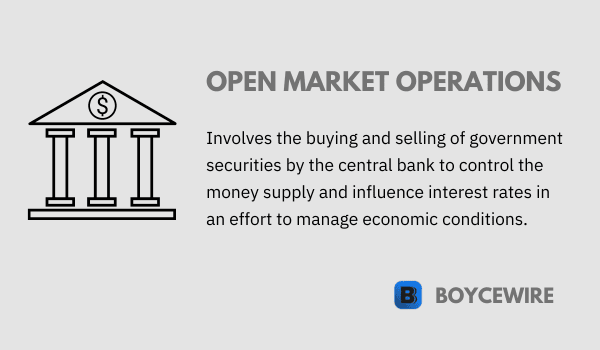Open Market Operations: Definition, Examples, Pros & Cons

What are Open Market Operations?
Open Market Operations (OMOs) are an essential tool used by central banks to implement monetary policy and regulate the money supply in the economy. Through OMOs, central banks buy or sell government securities, such as treasury bills, notes, and bonds, in the open market to influence short-term interest rates and achieve their policy objectives. These objectives often include maintaining price stability, promoting economic growth, and ensuring financial stability.
The role of central banks, such as the Federal Reserve in the United States, the European Central Bank in the Eurozone, and the Bank of Japan, is crucial in conducting open market operations. By altering the supply of money in the economy, these institutions can influence borrowing costs for businesses and consumers, thereby affecting investment, consumption, and overall economic activity. It is an essential component of modern monetary policy, enabling central banks to maintain a stable financial environment and foster sustainable growth.
Key Points
- Open market operations involve the buying and selling of government securities by the central bank in the open market.
- The primary purpose of open market operations is to influence and control the money supply, manage interest rates, and achieve macroeconomic objectives.
- Open market operations can be conducted through open market purchases (buying securities) or open market sales (selling securities).
Types of Open Market Operations
There are two primary types of open market operations that central banks utilize to achieve their monetary policy objectives:
- Outright Purchases (Expansionary OMOs): In an expansionary operation, a central bank purchases government securities from commercial banks and financial institutions, injecting money into the economy. This action increases the money supply, leading to a decrease in short-term interest rates. Lower interest rates make borrowing cheaper, encouraging businesses and consumers to spend and invest, which can stimulate economic growth. Expansionary OMOs are often employed during periods of economic slowdown or recession to boost economic activity.
- Outright Sales (Contractionary OMOs): In a contractionary open market operation, the central bank sells government securities to commercial banks and financial institutions, removing money from the economy. This action reduces the money supply, leading to an increase in short-term interest rates. Higher interest rates make borrowing more expensive, discouraging spending and investment, which can help curb inflation. Contractionary OMOs are often used during periods of rapid economic growth or high inflation to cool down the economy and maintain price stability.
It is essential to note that open market operations can also involve repurchase agreements (repos) and reverse repurchase agreements (reverse repos). These are short-term transactions where the central bank temporarily buys or sells government securities with an agreement to reverse the transaction at a later date. Repos and reverse repos can be used for managing short-term liquidity needs and fine-tuning the money supply in the economy.
Tools Used in Open Market Operations
Central banks utilize various tools to implement open market operations effectively. Some of the key tools include:
- Government Securities: These are financial instruments issued by the government to raise funds and regulate the money supply. Central banks buy and sell government securities, such as treasury bills, notes, and bonds, to conduct such operations. The choice of security depends on the maturity and the liquidity needs of the central bank.
- Repurchase Agreements (Repos) and Reverse Repurchase Agreements (Reverse Repos): Repos and reverse repos are short-term transactions used to manage liquidity in the financial system. In a repo transaction, the central bank buys government securities from commercial banks and agrees to sell them back at a specified date and price. This injects liquidity into the financial system. Conversely, in a reverse repo transaction, the central bank sells government securities and agrees to repurchase them later, removing liquidity from the system. These tools enable the central bank to manage short-term fluctuations in the money supply.
- Central Bank’s Discount Window: While not a direct tool for open market operations, the discount window plays a role in setting the tone for interest rates in the economy. The discount window is a facility provided by the central bank, allowing commercial banks to borrow funds at the central bank’s set interest rate. By adjusting the discount rate, the central bank influences short-term interest rates, which indirectly affects such operations.
- Communication and Forward Guidance: Central banks often use communication and forward guidance to signal their intentions regarding monetary policy and open market operations. This allows market participants to adjust their expectations, which can have an impact on interest rates and its effectiveness. By providing clear guidance on their policy stance, central banks can influence the behavior of financial institutions and investors, further helping to achieve their monetary policy objectives.
These tools, when used in combination, allow central banks to control the money supply, influence interest rates, and maintain stability in the financial system. Open market operations play a crucial role in implementing monetary policy and ensuring the smooth functioning of the economy.
Effects of Open Market Operations
Open market operations have significant effects on the economy, financial markets, and the banking system. Some of the key effects include:
- Money Supply: Such operations directly influence the money supply in the economy. When a central bank purchases government securities, it injects money into the banking system, increasing the money supply. Conversely, when it sells government securities, it removes money from the banking system, decreasing the money supply. These actions help the central bank maintain its target interest rate and control inflation.
- Interest Rates: The primary objective is to achieve the central bank’s target interest rate. When the central bank buys government securities, it increases the demand for these securities, which in turn lowers their yield or interest rate. This action also causes short-term interest rates to fall, making borrowing cheaper for businesses and consumers. On the other hand, when the central bank sells government securities, the increased supply leads to higher yields, causing short-term interest rates to rise and making borrowing more expensive.
- Economic Growth: Open market operations can influence economic growth by affecting the availability and cost of credit. When the central bank lowers interest rates through open market operations, borrowing becomes more affordable, which can stimulate investment and consumption, leading to economic growth. On the other hand, higher interest rates can discourage borrowing and spending, potentially slowing down the economy.
- Inflation: By controlling the money supply and interest rates, open market operations can help manage inflation. When the central bank decreases the money supply and raises interest rates, it can curb inflationary pressures by reducing the demand for goods and services. Conversely, increasing the money supply and lowering interest rates can stimulate demand and potentially lead to higher inflation.
- Financial Markets: Open market operations can impact financial markets by affecting the supply and demand for government securities, which in turn influences market interest rates. These actions can also influence investor sentiment and the behavior of financial market participants, potentially affecting asset prices and market stability.
- Banking System: Open market operations can affect the liquidity and capital adequacy of banks. By altering the money supply, central banks can influence the amount of reserves held by commercial banks, affecting their ability to extend credit to businesses and consumers. This can have significant implications for the overall health of the banking system and the economy.
In summary, open market operations play a crucial role in implementing monetary policy and maintaining economic stability. They help central banks achieve their objectives of controlling inflation, promoting economic growth, and maintaining financial market stability by influencing the money supply, interest rates, and the overall economic environment.
Advantages of Open Market Operations
Open market operations offer several advantages as a key instrument of monetary policy. Some of the main advantages include:
1. Flexibility
Open market operations provide central banks with a high degree of flexibility in managing money supply and interest rates. They can quickly and easily adjust the volume and frequency of their operations in response to changing economic conditions, allowing them to react promptly to changes in market conditions or economic indicators.
2. Precision
Open market operations enable central banks to target specific interest rates with a high degree of precision. By adjusting the amount of government securities they buy or sell, central banks can fine-tune the money supply to achieve their desired interest rate targets, helping them maintain stable economic conditions.
3. Market-based Approach
Open market operations rely on market mechanisms, allowing central banks to influence interest rates and money supply without directly setting them. This approach respects the role of market forces in determining the allocation of resources and ensures that the central bank’s actions are aligned with the broader market environment.
4. Transparency
Open market operations are conducted in a transparent manner, with central banks typically announcing their intentions and providing information about the size and timing of their operations. This transparency helps market participants anticipate and adjust to the central bank’s actions, promoting stability and predictability in the financial markets.
5. Low Cost
Open market operations generally involve low transaction costs for central banks, as they involve the purchase or sale of government securities, which are typically highly liquid and traded in large volumes. This makes open market operations a cost-effective tool for implementing monetary policy.
6. Minimal Distortions
Open market operations involve the buying and selling of government securities, which are generally considered to have a low risk of default. This ensures that the central bank’s actions do not introduce significant distortions into the financial system or create moral hazard issues that could arise if they were to purchase riskier assets.
Overall, open market operations are an essential and advantageous tool for central banks in implementing monetary policy. They offer flexibility, precision, and transparency, while relying on market mechanisms to achieve their objectives. This enables central banks to maintain economic stability and effectively manage inflation and growth.
Disadvantages of Open Market Operations
Despite the numerous advantages of open market operations, there are also some disadvantages associated with their use as a tool for implementing monetary policy. Some of the main drawbacks include:
1. Limited Effectiveness in Low Interest Rate Environments
In periods of extremely low interest rates, such as during a liquidity trap, open market operations may lose their effectiveness in stimulating economic activity. This is because when interest rates are near zero, further reductions may not provide sufficient incentives for businesses and consumers to borrow and spend, limiting the impact on the economy.
2. Potential for Market Distortions
Open market operations involve the buying and selling of government securities, which can potentially distort the market for these securities. Large-scale interventions by central banks may lead to artificial demand or supply, affecting market prices and potentially leading to misallocation of resources.
3. Incomplete Transmission to Real Economy
The effectiveness of the central banks operations depends on the transmission of changes in interest rates and money supply to the broader economy. However, this transmission can be hampered by factors such as the health of the banking sector, financial market frictions, and the overall economic climate. As a result, it may not always lead to the desired changes in spending, investment, and economic growth.
4. Time Lags
While open market operations can be implemented quickly, there are often time lags between their implementation and their impact on the economy. It may take time for changes in interest rates to filter through to borrowing and spending decisions, making it difficult for central banks to achieve their desired outcomes in a timely manner.
5. Coordination Challenges
Open market operations are typically conducted by central banks independently, which can sometimes lead to coordination challenges between different countries. For example, if multiple central banks are conducting such operations simultaneously, their actions may have unintended consequences on global financial markets and exchange rates.
6. Reliance on Healthy Financial Markets
The effectiveness of open market operations depends on the smooth functioning of financial markets. If markets are disrupted or illiquid, central banks may struggle to execute their operations, potentially reducing their ability to influence interest rates and money supply.
While open market operations are a powerful tool for central banks in managing monetary policy, it is essential to recognize their limitations and potential disadvantages. This awareness can help policymakers design and implement more effective strategies to address economic challenges and maintain stability.
Real World Examples of Open Market Operations
Open market operations are used by central banks around the world to implement monetary policy. Here are some notable examples of open market operations in action:
- United States – Federal Reserve : The Federal Reserve, the central bank of the United States, conducts open market operations through its Open Market Desk at the Federal Reserve Bank of New York. One of the most well-known instances of open market operations in recent history was the implementation of quantitative easing (QE) following the global financial crisis of 2008. The Fed purchased large amounts of government bonds and mortgage-backed securities to lower long-term interest rates and inject liquidity into the financial system, helping to stabilize the economy.
- European Central Bank (ECB): The ECB is responsible for implementing monetary policy in the eurozone. It has used open market operations in various forms, including the Securities Markets Programme (SMP) during the European sovereign debt crisis, and more recently, the Pandemic Emergency Purchase Programme (PEPP) in response to the economic fallout from the COVID-19 pandemic. Both programs involved large-scale purchases of government bonds to help lower borrowing costs and support financial stability.
- Bank of Japan (BOJ): The BOJ has a long history of using open market operations to manage its monetary policy. In the early 2000s, it implemented a policy of “quantitative easing” to combat deflation and stagnation, buying government bonds and other assets to increase the money supply. More recently, the BOJ has implemented a policy of “yield curve control,” which involves purchasing government bonds to maintain a specific target for long-term interest rates, in addition to its short-term policy rate.
- Bank of England (BoE): The BoE uses open market operations as part of its monetary policy framework. Following the financial crisis of 2008, the BoE launched its Asset Purchase Facility (APF) to conduct quantitative easing. This involved buying large amounts of UK government bonds (gilts) to lower long-term interest rates and stimulate economic growth. The BoE also implemented additional asset purchases in response to the economic impact of the Brexit vote in 2016 and the COVID-19 pandemic in 2020.
These examples illustrate the widespread use of open market operations by central banks across the globe. While the specific details of each operation may vary, the overall goal is to manage interest rates, control money supply, and achieve macroeconomic stability.
Conclusion
Open market operations play a crucial role in the implementation of monetary policy by central banks worldwide. These operations, which involve the purchase and sale of government securities in the open market, allow central banks to manage interest rates and control the money supply, ultimately influencing economic growth, inflation, and financial stability.
The tools and types may vary across central banks, but their overall objectives remain consistent. Through such operations, central banks can effectively respond to economic fluctuations and maintain macroeconomic stability. While there are both advantages and disadvantages to using open market operations, their widespread use by central banks demonstrates their importance as a key component of monetary policy.
Real-world examples, such as the Federal Reserve’s quantitative easing program or the European Central Bank’s various bond-buying initiatives, highlight the adaptability of such operations in addressing diverse economic challenges. As central banks continue to adapt and refine their monetary policy strategies, open market operations will remain an essential tool in their arsenal.
FAQs
Open market operations refer to the buying and selling of government securities (such as treasury bonds or bills) by the central bank in the open market.
The primary purpose of open market operations is to influence and control the money supply in an economy, manage interest rates, and achieve desired macroeconomic objectives, such as price stability and economic growth.
The central bank conducts open market operations by buying or selling government securities. When the central bank buys securities, it injects money into the economy, increasing the money supply. Conversely, when it sells securities, it withdraws money from the economy, reducing the money supply.
The central bank typically uses two main tools in open market operations: (1) Open market purchases, where it buys government securities, and (2) Open market sales, where it sells government securities.
About Paul
Paul Boyce is an economics editor with over 10 years experience in the industry. Currently working as a consultant within the financial services sector, Paul is the CEO and chief editor of BoyceWire. He has written publications for FEE, the Mises Institute, and many others.

Further Reading
 Fisher Equation - The Fisher equation relates nominal interest rates, real interest rates, and expected inflation, providing insight into the interplay between interest…
Fisher Equation - The Fisher equation relates nominal interest rates, real interest rates, and expected inflation, providing insight into the interplay between interest…  Determinants of Demand - Determinants of demand are the various factors that influence the quantity of a good or service that consumers are willing…
Determinants of Demand - Determinants of demand are the various factors that influence the quantity of a good or service that consumers are willing…  Framing Effect: What it is, Types & Examples - The framing effect is a cognitive bias that impacts our decision making when said if different ways. In other words,…
Framing Effect: What it is, Types & Examples - The framing effect is a cognitive bias that impacts our decision making when said if different ways. In other words,… 